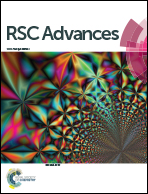Carbon nanotube-induced morphological transformation for toughening of benzoxazole-containing semi-crystalline polyimide
Abstract
Carbon nanotube (CNT)/semi-crystalline polyimide (PI) nanocomposites have been prepared by incorporating different concentrations of carboxylic acid-functionalized multi-walled CNTs. The incorporation of CNTs not only results in remarkable strength improvement, but also increases the toughness of nanocomposites. The toughness shows a maximum at the CNT concentration of 0.75 wt%, about twofold increment in toughness compared to neat PI. To explore the origin of this toughening behaviour, dispersion of nanotubes in the PI matrix and their interfacial interactions were investigated by TEM, FT-IR spectroscopy and UV-visible absorption spectroscopy, respectively. Morphological transformation of the crystalline phase induced by CNTs was monitored by polarized optical microscopy and WAXD. The fracture surfaces of CNT reinforced PI nanocomposites were investigated by SEM. It was suggested that the abrupt change of toughness with respect to CNT weight fraction is attributed to the percolation effects and concomitant morphological change, which was accounted for by a proposed model for nanotube-induced morphological transformation. The model provides novel insight into the design of strengthened and toughened materials by tailoring the structure at the nanoscale.


 Please wait while we load your content...
Please wait while we load your content...